
Original Link: https://www.anandtech.com/show/1982
OCZ EL PC2-8000 XTC: Low Latency PLUS DDR2-1100
by Wesley Fink on April 3, 2006 12:01 AM EST- Posted in
- Memory
OCZ EL PC2-8000 XTC
DDR2 is a subject whose time has come, but whose interest is lagging behind. In a few months everyone will be asking what memory they should use with AM2 or Conroe, but for now everyone seems to be like a deer caught in headlights waiting for what will happen. One thing IS certain in today's climate and that is your next memory purchase will be DDR2. Whether AMD or Conroe you should be looking for the fastest and lowest latency DDR2 memory you can find.
The problem, of course, is the lingering perception that DDR2 memory means high latency. That certainly appeared the case when DDR2 was first introduced, but DDR2 development continues. One of the first real DDR2 stars was Micron D fat body chips, which seemed to be used in every early DDR2 memory once memory companies realized how good they were. In a day where DDR2-400 was 1:1, the Micron DDR2 chips could be pushed all the way to DDR2-800 and beyond - and they could reach these speeds at the fastest timings (the lowest latencies) you could find in the market.
A few Intel enthusiasts paid a lot of attention to the Micron fat body D chips, but the rest of the enthusiast world was running in droves to the AMD platform which used older DDR memory instead. As a result Micron fat body D chips were only being talked about by a few die-hard Intel enthusiasts. Then Micron did what they have done many times before with some of their great enthusiast parts. They discontinued fat-body D chips, claiming yields (translate to profits) were not good enough to continue making what were clearly the best DDR2 chips on the market.
Since that time, nothing has really come along that is quite as good as the discontinued Micron fat-body D chips. Progress has been made by several memory manufacturers, and the current darling of DDR2 chips is made by Elpida. 2GB kits (2x1GB DIMMs) based on Elpida chips perform nearly as well as the legendary Micron chips. You can clearly see this typically excellent Elpida DDR2 performance in our recent review, Mushkin XP2 PC2-5300 DDR2 - Xtreme Performance Memory.
The computer enthusiast world is now looking for even more in DDR2 memory. With AM2 expected in June/July, potential buyers are talking about the possible impact of very low DDR2 latencies with the on-chip memory controller that will be featured in the new AM2 processor. With Conroe looking to regain the performance crown, potential buyers are also realizing that without the deep pipes of Intel NetBurst, not only will performance improve, but low DDR2 memory latencies might finally make a performance difference on the Intel platform. The new mantra for DDR2 memory has become low latency, but it is important to understand what that means.
It is too much for this review to look deeply at the DDR2 architecture, but it is important to understand that CAS latency does not work the same way in DDR2 as we have seen in DDR memory. As a result CAS 2 is not even an option in current DDR2 controllers, with CAS 3 a very fast option for DDR2 memory. We have all learned in DDR that the best tRAS performance is NOT normally the fastest tRAS setting, but one that is balanced to the chipset/memory controller architecture. This lesson also carries over to DDR2, with the result that best performance often comes with higher tRAS settings.
All of this leads to the quesion of what are the fastest DDR2 memory timings you can possibly find today in DDR2 memory? The answer is CAS 3, with a current range of CAS 3 to 6, RAS Precharge of 2, with a range from 2 to 6, RAS to CAS Delay of 2 with a range of 2 to 6, and tRAS (RAS Activate to Charge) dependant on chipset/memory controller with a broad range from 4 to 18 in some BIOS. tRAS settings are generally higher in DDR2, with best performance settings commonly in the 9 to 15 range. All of this translates into the lowest latency memory you can conceive today having timings of 3-2-2-9.
With 3-2-2 as the DDR2 Holy Grail, you have a clear idea of the expectations for any new DDR2 memory. There has been huge speculation that Micron's newest memory chips might be this new DDR2 "standard bearer", and it seems it has taken a very long time for Micron to finally deliver these new chips. The first memory we have received with the new Micron DDR2 chips is OCZ EL PC2-8000 XTC.
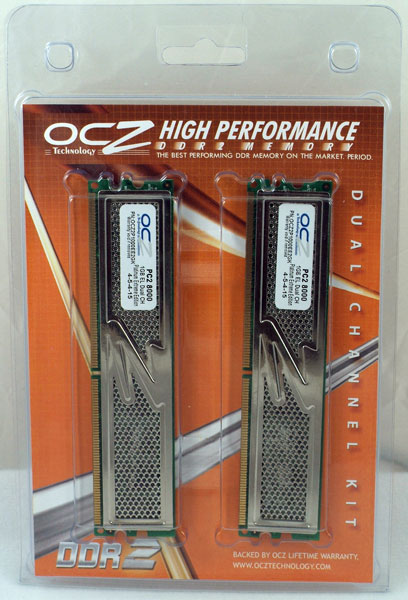
The OCZ PC2-8000 features the new Micron memory chips, and as you can see from the package it also is a featured member of the Platinum series with the latest "mirrored" XTC perforated heatsinks, and the EL (Enhanced Latency) technology introduced by OCZ. The real question is whether the new Micron chips and the other nice OCZ features translate into groundbreaking DDR2 performance. Is this a memory you would proudly pair with a new AM2 or Conroe processor?
Product Specifications and Information
OCZ confirmed the use of Micron memory chips for their PC2-8000 EL memory. This new Micron chip is also a variant of the D die provided in 64x8 chips for the 2GB memory kits. OCZ provides this memory as the 1GB DIMMs we are testing in P/N OCZ2P10001GEE. The PC2-8000 EL is also available as 512MB DIMMs - P/N OCZ2P1000512EE. Both the 512MB and the 1GB DIMMs are available as matched pair kits of 1GB and 2GB.
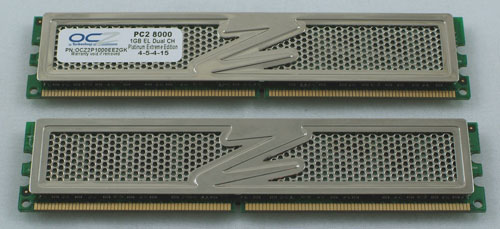
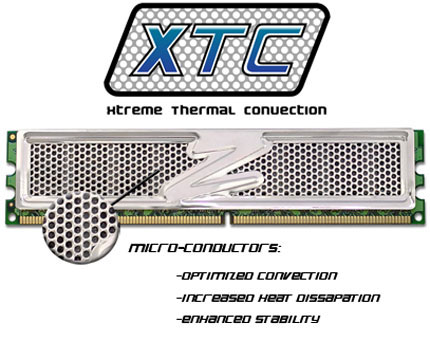
The XTC heatspreaders are certainly a great deal lighter than any non-perforated designs. They also appear to work well in dissipating heat, though to be honest we have found in the past that heat-spreaders provide very little improvement in heat dissipation compared to bare DIMMs. The larger surface area ought to benefit from active cooling and the DIMMs also have a unique look that some might find appealing. However, the bottom line is whether or not this memory lives up to performance expectations, and that's what we're here to find out.
Memory Test Configuration
We have reviewed several Intel 975x motherboards that overclock well and provide the kind of stability needed for a DDR2 memory test platform. However, OCZ PC2-8000 offered a unique challenge in that it is the first DDR2 memory we have tested rated at DDR2-1000. In addition we fully expected this memory to go well beyond DDR2-1000. We mention this only because most current motherboards are notoriously unreliable as platforms supporting memory speeds above DDR2-1000.
After talking with OCZ, Corsair, and several other enthusiast memory manufacturers, the consensus was that testing above DDR2-1000 would require an ASUS P5WD2-E motherboard. We had one memory test setup with the ASUS board, but our second test bed used another motherboard. To make sure we extracted all the performance possible from this OCZ PC2-8000 EL XTC, the main memory test bed was updated to the ASUS 975x test bed.
The Intel Pentium 955 Extreme Edition CPU, a 1066MHz FSB dual core solution containing 2MB of L2 cache onboard, was continued as our standard memory test CPU. The EE chips have the advantage of operating at 1066FSB, or 266 base, which raises the 1:1 memory to DDR2-533 instead of the DDR2-400 that is the 1:1 match for 800FSB.
The ASUS P5WD2-E supports a very wide range of memory speeds and FSB options. It also actually runs at all the supported settings. If you look closely at the table you will see that a 1066FSB CPU (or overclocked setting) is needed for support of DDR2-889 and DDR2-1067. It is therefore important to use a 1066FSB CPU when testing memory like the OCZ PC2-8000 which can operate at DDR2-1000 and faster. For additional information on the ASUS board, you can read our full ASUS P5WD2-E Premium review.
| Memory Configuration Options/ASUS P5WD2-E Premium Motherboard | ||||||||
| FSB/RAM | Auto | DDR2-400 | DDR2-533 | DDR2-667 | DDR2-711* | DDR2-800* | DDR2-889* | DDR2-1067* |
| FSB 1066 | X | X | X | X | X | X | X | X |
| FSB 800 | X | X | X | X | X | |||
| FSB 533 | X | X | X | |||||
Our memory test bench uses the following components:
| Memory Test Bench Specifications | |
| Processor: | Intel 955 Extreme Edition at 13X Ratio (3.46 GHZ dual core 65nm CPU) |
| RAM: | OCZ EL PC2-8000 XTC (2x1GB) Mushkin XP2 DDR2 PC2-5300 (2 x 1GB) Crucial Ballistix PC2-6400 (2 x 1GB) Crucial Ballistix PC2-5300 (2 x 1GB) OCZ Platinum EB PC2-4200 |
| Hard Drives: | Hitachi 200GB SATA2 Seagate 7200.9 ST3500641AS SATA NCQ - 16 MB Cache |
| Video Card: | ASUS 7800GTX TOP 256MB - set to 490MHz/1.3GHz EVGA 7800 GTX KO 256MB - 490MHz/1.3GHz |
| Video Drivers: | NVIDIA ForceWare 84.21 |
| Power Supply: | OCZ PowerStream 520W PC Power and Cooling Turbo-Cool 850-SSI |
| Operating System(s): | Windows XP Professional SP2 |
| Motherboard: | ASUS P5WD2-Premium |
| BIOS: | AMI version 0304 February 22; 2006 |
The OCZ EL PC2-8000 is based on the newest Micron memory chips, which are a variant of the Micron D die. The recently tested Mushkin DIMMs are based on Elpida chips. The other three memories - both Crucial DDR2 and the OCZ EB PC2-4200 - are all based on the now discontinued Micron fat-body D chips. The OCZ is based on early Micron DDR2 chips, while both Crucial Ballistix memories are based on later fat-body D versions.
Stock Memory Performance
As discussed in earlier DDR2 memory reviews, the Intel platform does not really allow for easily testing different memory speeds at the same CPU speed. Instead most top motherboards provide a wide range of memory ratios that match available DDR2 memory. Most end-users can therefore select the memory ratio that matches their DDR2 memory speed. For those reasons, we first tested all of the stock ratios at the fastest stable timings we could achieve at the given ratio. With ratios, CPU speed remains the same at 3.46GHz in our memory test bed, and memory speed is varied by selecting different ratios.
| OCZ EL PC2-8000 XTC (Stock Memory Ratios) - 2x1GB Double-Bank | |||||||
| CPU Ratio at 3.47 GHz |
Memory Speed |
Best Memory Timings (Voltage) |
Far Cry (fps) |
Sandra Unbuffered |
Sandra Standard Buffered |
SuperPi Mod 1.4 2M places (time in sec) |
Half Life 2: Lost Coast (fps) |
| (4:3) | 400 DDR2 |
3-2-2-6 1T 1.8V |
61.5 | INT 3001 FLT 3037 |
INT 5614 FLT 5608 |
87.6 | 75.6 |
| (1:1) | 533 DDR2 |
3-2-2-9 1T 2.1V |
63.07 | INT 3570 FLT 3600 |
INT 6500 FLT 6498 |
85.3 | 84.2 |
| (4:5) | 667 DDR2 |
3-2-3-10 1T 2.1V |
63.07 | INT 3999 FLT 3995 |
INT 6710 FLT 6691 |
84.7 | 83.4 |
| (2:3) | 800 DDR2 |
3-3-3-11 1T 2.1V |
64.52 | INT 4301 FLT 4356 |
INT 6774 FLT 6788 |
83 .3 | 81.7 |
| (1:2) | 1066 DDR2 |
4-4-5-14 1T 2.3V |
64.38 | INT 4576 FLT 4639 |
INT 6840 FLT 6843 |
82.1 | 81.2 |
| *Rated Speed Overclocked 3:5 (300x13) |
1000 DDR2* | 4-3-4-12 1T 2.2V |
64.75 | INT 4982 FLT 5046 |
INT 7649 FLT 7654 |
72.9 | 95.2 |
| Highest Performance Overclocked 3:5 (318x13) |
1060 DDR2 | 4-3-4-14 1T 2.3V |
75.06 | INT 5260 FLT 5303 |
INT 8105 FLT 8107 |
69.1 | 96.7 |
| Highest Mem Speed Overclocked 1:2 (275x13) |
1100 DDR2 | 5-4-5-15 1T 2.35V |
66.21 | INT 4720 FLT 4785 |
INT 6952 FLT 6947 |
80.2 | 89.8 |
Since the OCZ PC2-8000 EL is rated at DDR2-1000, the 1000 speed was also tested. To achieve that speed the 889 memory speed was selected at the standard 1066 FSB (266 setting quad pumped). The FSB was then overclocked to 300 (1200 FSB) resulting in a memory speed of DDR2-1000. You can clearly see that the OCZ PC2-8000 EL performed much better than the rated timings of 4-4-5-15. Our testing found complete stability at DDR2-1000 at 4-3-4-12 timings.
In the introduction it was pointed out that the fastest possible timings with today's DDR2 are 3-2-2. If you look closely you will see the OCZ PC2-8000 works fine at the fastest timings that can be selected at both DDR2-400 and the 1:1 memory setting of DDR2-533. These are both the fastest timings we have ever been able to run with complete stability with DDR2. In fact all the way up to DDR2-1066 this new PC2-8000 memory sets new records for the lowest latencies we have found in testing DDR2 memory.
Despite the fact that CPU multipliers can not be dropped below 12X on the Intel platform, it is important to keep in mind that the first 5 table rows, from DDR2-400 to DDR2-1066, represent a constant CPU speed of 3.46GHz with memory running at faster speeds through ratios. 1:1 should always have the least overhead in the current Intel universe, but the DDR2 memory still scales well with speed over the full range. Memory bandwidth improves with memory speed, as does raw calculation performance. However, this does not always translate into linear gaming performance curves in Half Life 2: Lost Coast and Far Cry.
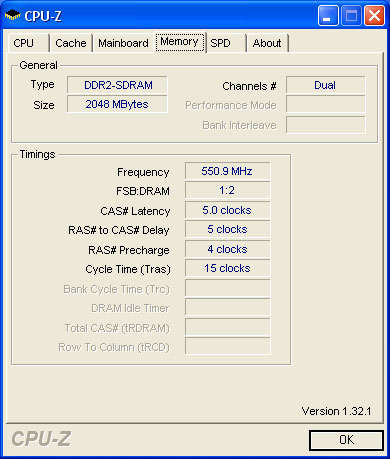
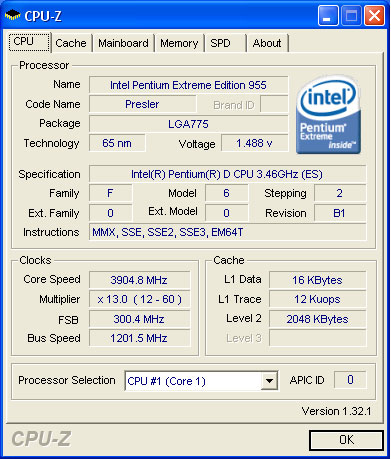
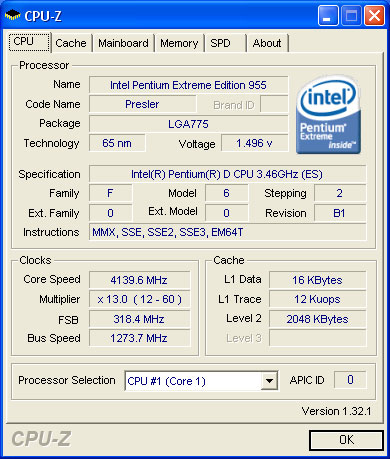
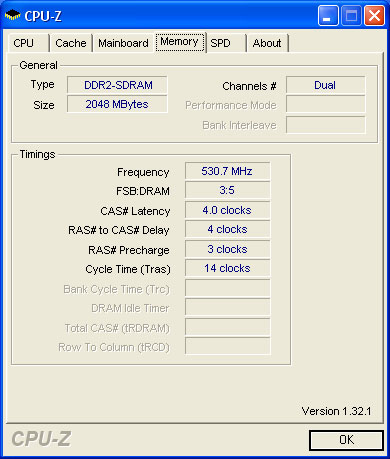
There are other possible approaches to overclocking DDR2 memory on the Intel platform. Probably the most logical, given the memory controller resides on the Intel chipset rather than the processor, is to look at overclocking at a 1:1 ratio. For our test setup that means a DDR2-533 base setting. You can see results of that approach on page 10.
DDR2 400 (4:3) Performance
With a CPU rated at 1066 FSB (Quad 266), DDR2-400 is an underclock ratio for memory. It is not likely users would want to run at this speed unless they have very old DDR2 memory that can not run at faster speeds at tight timings. This speed is included mainly for reference - to compare tested memory to past DDR2 memory performance.
The OCZ PC2-8000 is able to handle DDR2-400 at the fastest timings you can select in memory at 3-2-2. This low-latency performance is reflected in PC2-8000 topping all the DDR2-400 performance charts.
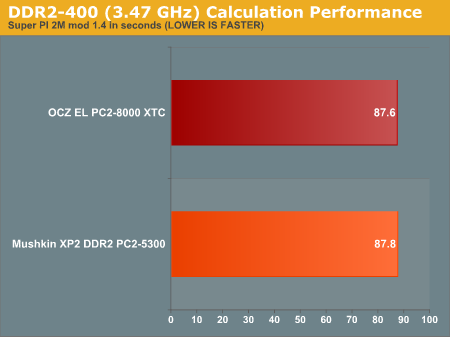
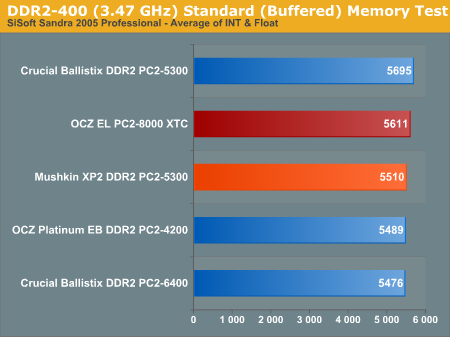
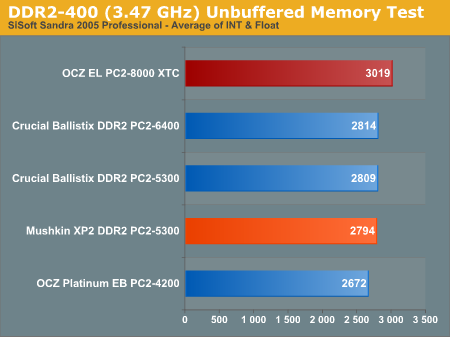
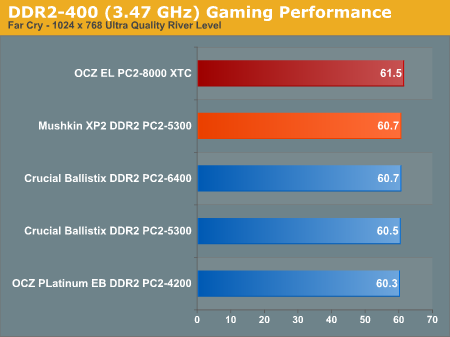
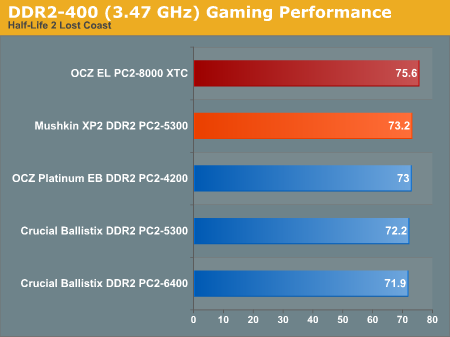
DDR2 533 (1:1) Performance
The DDR2-533 memory speed is important with a 1066 FSB CPU because it represents 1:1 memory performance. On Intel platforms the memory controller is still a part of the chipset and not on-processor as it is on the Athlon 64. As a result you would generally expect the fastest memory performance possible on an Intel board by running the memory at a 1:1 ratio.
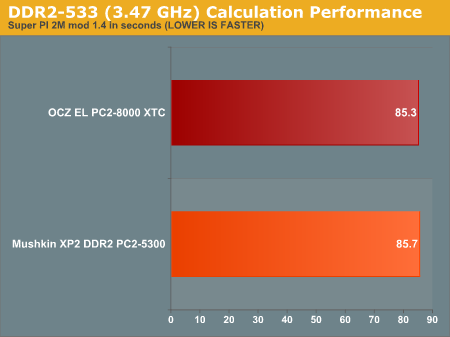
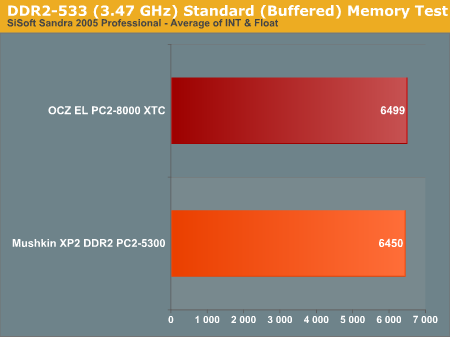
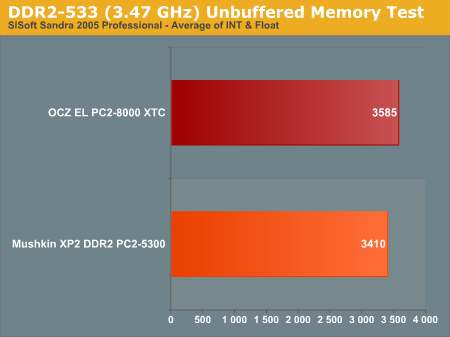
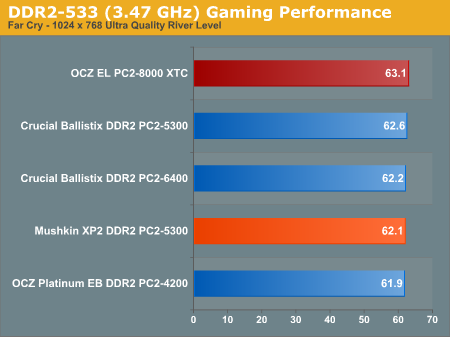
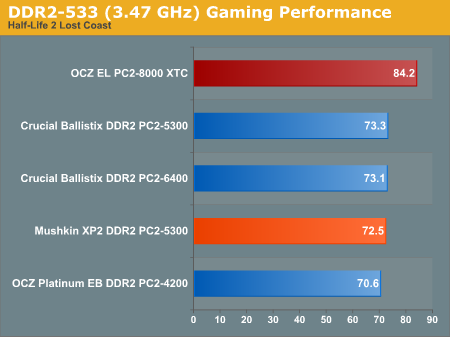
DDR2 667 (4:5) Performance
The incredible timings possible with OCZ PC2-8000 are reflected in top performance at DDR2-667. While the differences in performance are not huge, OCZ still outperforms other tested DDR2 2GB kits in every benchmark.
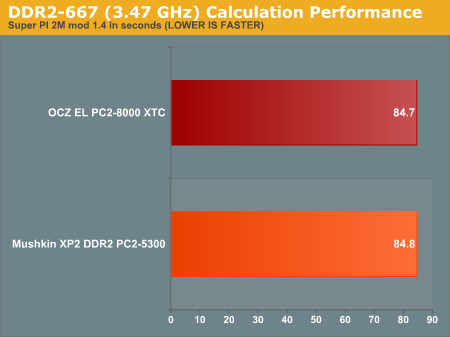
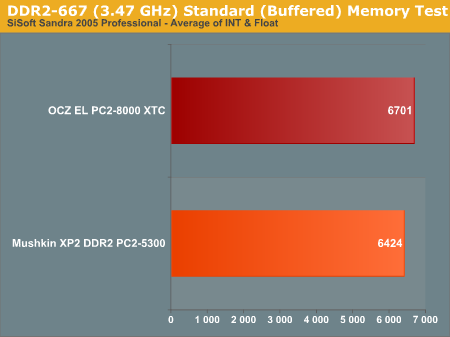
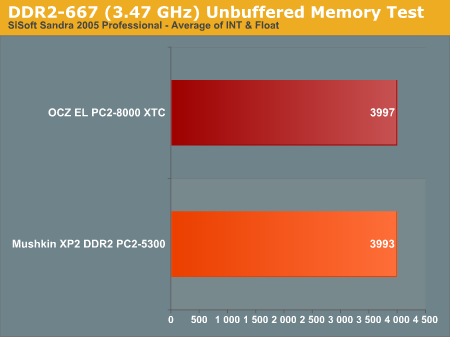
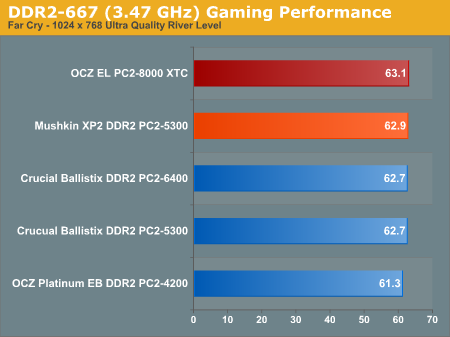
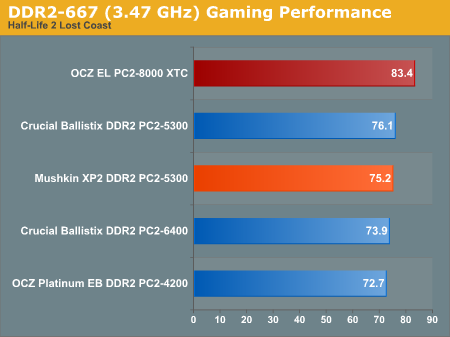
DDR2 800 (2:3) Performance
At DDR2-800 the OCZ EL PC2-8000 and Mushkin Elpida DIMMs are running at the same 3-3-3 timings. As a result performance for both memories is very close. OCZ still tops the charts, but the margins are generally razor thin and well within our confidence level.
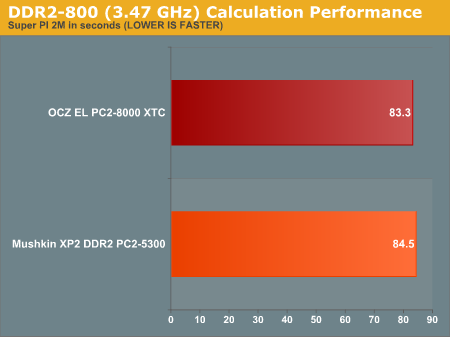
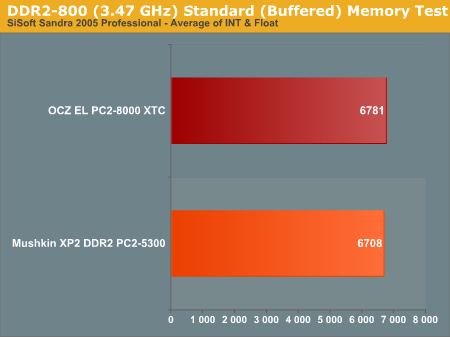
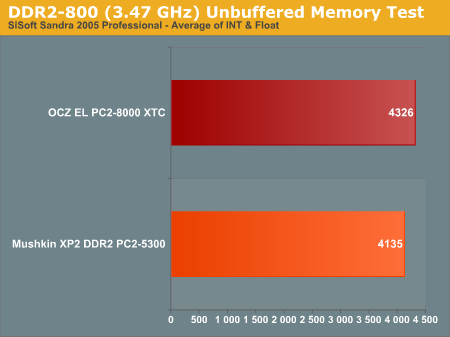
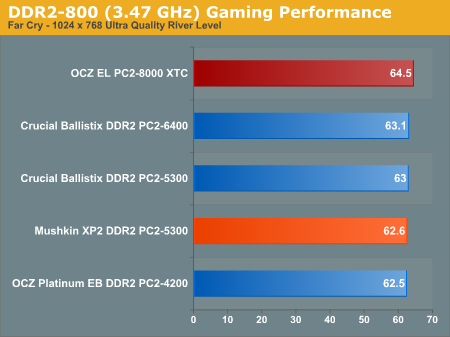
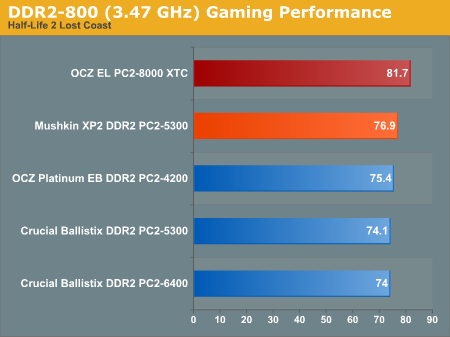
Highest Memory Speed (Highest Ratio) Performance
The Highest Ratio Memory Speed results are rather odd when we used the DDR2-1000 results for comparison. This does NOT mean the OCZ is slower, it is just an anomaly of the test procedure. The OCZ is the first memory that can reach 1067 in our testing, and the Highest Ratio speed is therefore only slightly above the 1067 speed at DDR2-1100. Other memories required more overclocking from the DDR2-800 lower ratio to reach their top speed, and thus were running at a higher CPU speed than the OCZ at DDR2-1100. To provide a fairer assessment of the top ratio speed we used results of the OCZ PC2-8000 running at a DDR2-889 base ratio at DDR2-1060 - the highest stable speed we could achieve with 4-3-4 memory timings..
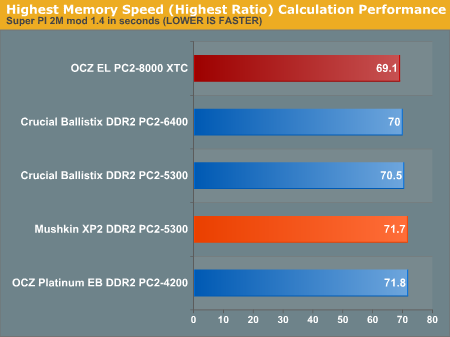
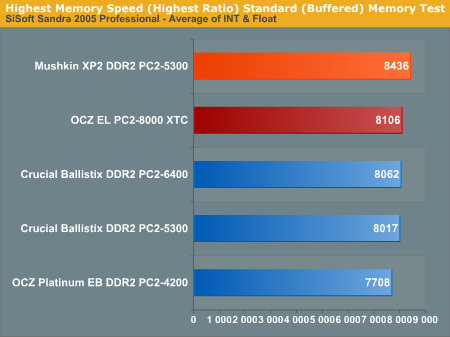
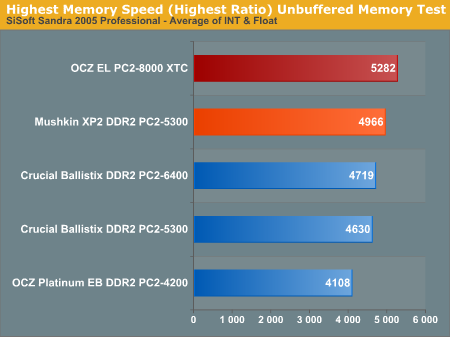
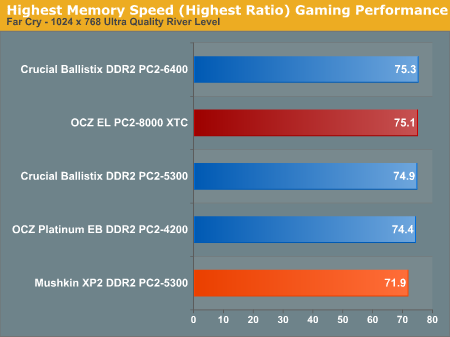
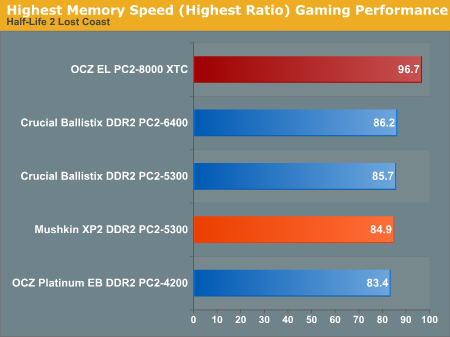
Overclocking Performance
We were able to overclock using the DDR2-533, DDR2-667, DDR2-711, DDR2-800, DDR2-889, or DDR2-1066 memory straps. Since the Presler 955 Extreme Edition processor utilizes a 1066 MHz bus speed it allows us to use the 1:1 memory to FSB clock ratio when the front side bus speed is set to 266 MHz. Keep in mind that the Intel FSB is quad-pumped, which is why a setting of 266 yields a FSB of 1066 (4x266). DDR2 Memory on the Intel platform, however, is by definition Double Data Rate, so a 266 base setting is 533 (2x266). The dual-channel setups used in nearly all systems keep the bandwidths matched, however, given 2 x DDR2-533 bandwidth.
| OCZ EL PC2-8000 XTC (1:1 Memory Ratio) - 2x1GB Double-Bank | |||||||
| CPU Settings |
Memory Speed (1:1) |
Best Memory Timings (Voltage) |
Far Cry (fps) |
Sandra Unbuffered |
Sandra Standard Buffered |
SuperPi Mod 1.4 2M places (time in sec) |
Half Life 2: Lost Coast (fps) |
| 13x267 | 533 DDR2 |
3-2-2-9 1T 2.1V |
63.1 | INT 3570 FLT 3600 |
INT 6500 FLT 6498 |
85 | 84.2 |
| 13x333 | 667 DDR2 |
3-2-3-11 1T 2.1V |
73.9 | INT 4368 FLT 4414 |
INT 8108 FLT 8097 |
68.1 | 106.3 |
| 13x352 | 704 DDR2 |
3-3-3-11 1T 2.2V |
83 | INT 4512 FLT 4630 |
INT 8494 FLT 8504 |
64.9 | 109.8 |
The chart above indicates relative scaling with front side bus speed increases from a 1:1 memory strap (DDR2-533). SiSoft Sandra Professional Buffered and Unbuffered memory scoring were both included in benchmarking, along with SuperPi time to calculate 2 million places in seconds. The Half Life 2: Lost Coast benchmark was run at 1024x768 resolution at maximum quality settings with HDR on. Far Cry was set for ultra quality in the settings with a resolution of 1024 x 768.
Using the stock 13X multiplier of the 955 EE Presler, we were able to hit 352 FSB at the lowest timings of 3-3-3-11. While higher 1:1 settings were possible, they were not completely stable with our air-cooling setup. That makes the CPU the likely road block to further overclocking with an effective limitation of about 4.5GHz on stock air cooling.
The OCZ PC2-8000 operated with no heat problems up to 2.2V, which covered the majority of benchmarking. Above 2.2 the memory heats up quickly and performs best with an auxiliary fan cooling the memory.
Highest Memory Speed (1:1 Ratio) Performance
Performance comparisons at the highest 1:1 memory speed are really comparing the top CPU speed that can be reached on stock air cooling with the Presler 955EE. This is one of the limitations of testing on the current Intel platform. Once the test bed is moved to AM2, assuming AM2 will continue Cool'n'Quiet and lower ratios available on all A64 processors, then we should be able to really determine the highest Memory Speed possible with a given memory instead of the highest CPU speed a processor can reach on stock air. Nonetheless, the OCZ PC2-8000 does very well. It again tops the memory performance charts in our 5 benchmarks.
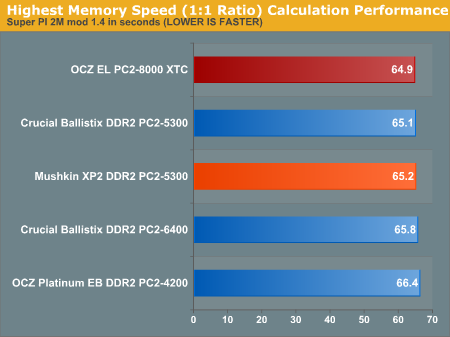
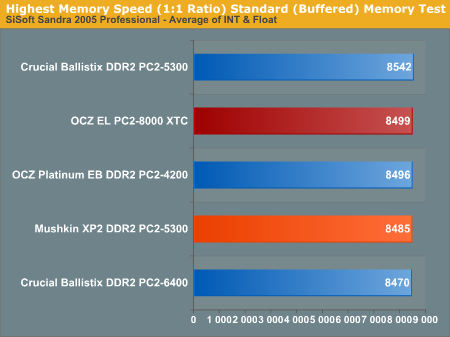
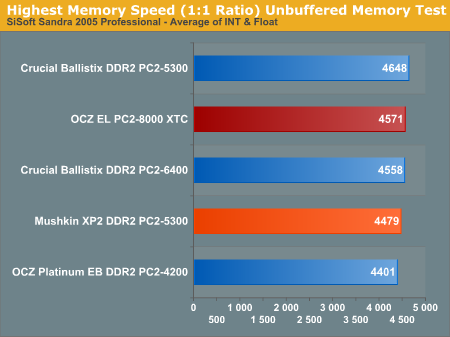
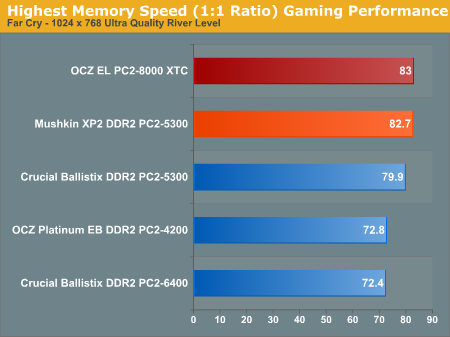
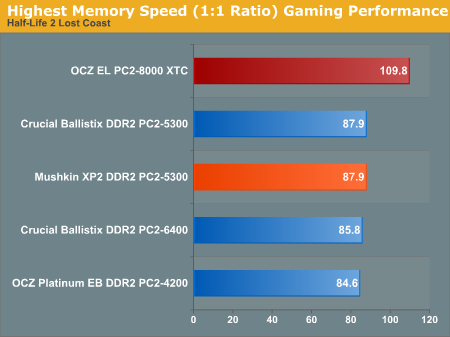
Final Words
A few readers will understand the significance of the performance of the new OCZ EL PC2-8000 XTC memory right now. Generally they will be readers who have tested and understand the limitations of current DDR2 memory. Others will not likely realize how good this OCZ memory, based on the new Micron chips, really is until the market moves to AM2 and Conroe. To be perfectly clear this new OCZ memory is better than the legendary Micron fat-body D chips from the past in every way.
The OCZ EL PC2-8000 XTC performs at the fastest timings possible on current DDR2 platforms at both DDR2-400 and the 1:1 ratio DDR2-533. It also reaches higher than any DDR2 memory we have ever tested, reaching an ultimate DDR2-1100 speed. At all of these higher memory speeds, memory timings and latencies are the lowest we have ever seen with DDR2 memory. It will be very interesting to retest this memory when AM2 and Conroe arrive, simply because current NetBurst technology more than likely obscures the real performance advantages of this new OCZ memory based on the latest Micron chips.
It is clear in our performance charts that 1:1 is not absolutely necessary for the best performance with this fast memory. The sweet spot is a combination of memory speed, possible timings, and the degree of overclock. With these considerations, OCZ has done a masterful marketing job in rating this memory at DDR2-1000. At this speed the overclock to 300 combined with the still aggressive 4-3-4 timings yields impressive performance. Anyone who runs this 2 GB kit at DDR2-1000 to DDR2-1060 with 4-3-4 timings will think they have died and gone to heaven. The performance is that stable and that impressive. It is all the more remarkable when you consider that this is the preferred 2GB kit (2x1GB) instead of the 1GB kit (2x512MB) that normally has an easier time reaching high overclocks.
Some readers will immediately notice that the performance advantage over the excellent Mushkin Elpida and the older Micron chips is not really that much. That is certainly true, but we are comparing some of the best DDR2 memories of today and the past to the new OCZ memory and the OCZ wins almost every comparison. We fully expect the AM2 on-processor memory controller and the Conroe shallower pipes to better demonstrate the advantages of low-latency DDR2. Frankly, much of the potential is lost on NetBurst, but this new memory still tops the charts in performance.
One note of precaution: as pointed out in past memory reviews, huge increases in memory bandwidth usually translate into much smaller gains in real-world gaming performance and other real-world test results. Memory is just one part of the total performance equation. Other components, in particular the video card, have a dramatic impact on final performance of most real-world tasks. You can also expect a bigger difference in performance between this super fast OCZ DDR2 and regular slower DDR2 on the upcoming AM2 and Conroe architectures.
The OCZ EL PC2-8000 XTC seems to perform best at a CAS setting of 4 or 3. We often found we could stabilize performance just by moving down from CAS 5 to CAS 4 in our testing. DDR2-1100 required CAS 5, but we reached near that speed at DDR2-1080 with CAS 4. Voltage is also an important consideration. Anything up to 2.2V appeared to work fine with no cooling issues, but once you venture over 2.2V heat goes up fast. Above 2.2V we would recommend that you run an auxiliary fan with this OCZ memory.
Our advice? If you are buying for a DDR2 system this is the fastest and lowest latency DDR2 memory we have ever tested. It will work well with your current Intel system, and move very well to an even better performing AM2 or Conroe DDR2 system. If you are like most of our readers, you are using an AMD Athlon64 system waiting to see what develops in AM2 and Conroe. You will not have any current use for this terrific DDR2 memory, but it should be the first DDR2 memory to add to your shopping list for the future. There will likely be other DDR2 memory to consider, as we already know Corsair and other enthusiast memory manufacturers are also preparing to ship products based on these new Micron memory chips. Time will tell if the competitors do as well as OCZ at binning and tweaking these new chips.
 OCZ EL PC2-8000 is the best performing DDR2 memory ever tested at AnandTech. We expect to receive memory from competitors based on the new Micron chips in the near future. It may be similarly impressive, but OCZ is the first to bring these new Micron DDR2 chips to market. We are pleased to award OCZ EL PC2-8000 XTC our Gold Editor's Choice for the best performing DDR2 memory you can currently buy. This memory provides the lowest DDR2 memory timings possible to DDR2-533. The memory is rated at DDR2-1000 and provides exceptional performance all the way to DDR2-1100 at the fastest timings and lowest latencies seen in any DDR2 memory. OCZ EL PC2-8000 XTC is a very welcome addition to the Memory Market.
OCZ EL PC2-8000 is the best performing DDR2 memory ever tested at AnandTech. We expect to receive memory from competitors based on the new Micron chips in the near future. It may be similarly impressive, but OCZ is the first to bring these new Micron DDR2 chips to market. We are pleased to award OCZ EL PC2-8000 XTC our Gold Editor's Choice for the best performing DDR2 memory you can currently buy. This memory provides the lowest DDR2 memory timings possible to DDR2-533. The memory is rated at DDR2-1000 and provides exceptional performance all the way to DDR2-1100 at the fastest timings and lowest latencies seen in any DDR2 memory. OCZ EL PC2-8000 XTC is a very welcome addition to the Memory Market. The introduction of this impressive new OCZ DDR2 memory provides us with a real tool to exploit the low-latency potential of the upcoming AM2 and Conroe platforms. The timing is just a little early, but it won't be long until this becomes one of the most sought after memories in the world.







